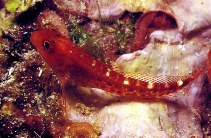| Family: |
Blenniidae (Combtooth blennies), subfamily: Salariinae |
| Max. size: |
7 cm TL (male/unsexed) |
| Environment: |
demersal; marine; depth range 6 - 12 m |
| Distribution: |
Mediterranean Sea and Black Sea. |
| Diagnosis: |
Dorsal spines (total): 12-12; Dorsal soft rays (total): 18-18; Anal spines: 2-2; Anal soft rays: 19-20 |
| Biology: |
Adults inhabit dimly lit biotopes like overhanging rocks or caves. Also found in piddock holes. They graze on periphyton (Ref. 5981). Oviparous. Eggs are demersal and adhesive (Ref. 205), and are attached to the substrate via a filamentous, adhesive pad or pedestal (Ref. 94114). Larvae are planktonic, often found in shallow, coastal waters (Ref. 94114). |
| IUCN Red List Status: |
Least Concern (LC); Date assessed: 11 March 2014 Ref. (130435)
|
| Threat to humans: |
harmless |
Source and more info: www.fishbase.org. For personal, classroom, and other internal use only. Not for publication.

